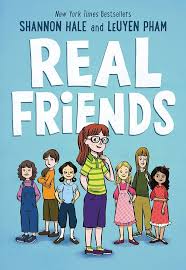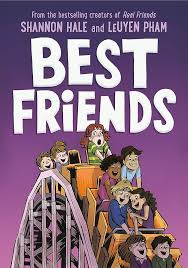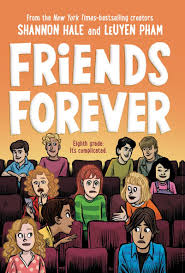Friendships can be challenging, especially in middle school. In her Real Friends series, Shannon Hale writes three graphic novel memoirs chronicling her changing friendship groups from elementary school through middle school.
Shannon touches on many important elements of adolescence including mental health, toxic friendships, and crushes. I believe it is her realistic representation of the difficulties many growing children face that make these books so relatable and popular. There are, however, several complicated scenes that I think would be helpful to talk through with an adult.
Before I address a few more specific occurrences in the books below, I want to note that the stories take place during the 1970’s and 80’s. While the references to iconic songs and television shows are entertaining, unfortunately, some of the adult’s reactions to Shannon’s anxiety, OCD, and depression struggles are not always positive. I found it very helpful to point out to my daughter that in our current time we are trying as a society to put more emphasis on understanding and treating mental health today.
It is also important to note that there is a big jump from one book to another in age. The first book, Real Friends, focuses on Shannon’s elementary school experience. The second and third books, Best Friends and Friends Forever, explore her middle school and junior high years, which may be too mature for younger readers.
One last comment. In my description of the books below, I am pointing out several of the more difficult scenes to help prepare you for discussions with readers, NOT to deter you or your children from reading these books. There is a reason they are bestsellers and constantly checked out from library shelves. Children find them extremely relatable. Friendships can be stressful and observing someone else navigating them through good and bad times can help readers feel less alone. Shannon specifically mentions in her author’s note that she created these memoirs to share the way she felt during these challenging times in her life in hopes that if others have had similar occurrences, they won’t feel alone.
These books are important and are an excellent avenue for powerful conversations between adults and children.
*This post contains affiliate links. To read my full disclosure CLICK HERE.
 Real Friends by Shannon Hale, illustrated by LeUyen Pham
Real Friends by Shannon Hale, illustrated by LeUyen Pham
This book follows Shannon through her experiences starting school and navigating different friendships in kindergarten through fifth grade with most of the emphasis on third, fourth, and fifth grade.
What to know before you read:
- The girls in the story can be very mean to each other. Shannon’s “friends” and big sister say and do especially cruel things to her. This was a major talking point with my daughter about the right and wrong ways to treat friends and how Shannon dealt with their behavior. It also gave us the opportunity to discuss why the girls act so unkindly, often due to jealousy and their own negative feelings about themselves.
- The girls form a clique with a “queen bee,” and Shannon struggles with feeling included. The popular girls become interested in boys at a young age and there is even a scene early on where a second-grade boy grabs a girl and kisses her. Shannon immediately jumps in to help her friend and they quickly move on from it. This scene allowed my daughter and I to have a very productive conversation on boundaries and appropriate and inappropriate touching.
- Shannon experiences anxiety and develops mild OCD from the stress of her friendships. One of the book’s highlights is Shannon gaining confidence as she gets older and befriends new people.
 Best Friends by Shannon Hale, illustrated by LeUyen Pham
Best Friends by Shannon Hale, illustrated by LeUyen Pham
As Shannon enters her sixth-grade year, she experiences a roller coaster of emotions as she changes from child to a preteen. The book chronicles her experience trying to navigate what to say and do in order to fit in with her friends while also trying to be true to herself.
What to know before you read:
- Girls continue to act petty, gossip, and lie about each other. As they broach puberty, there are discussions about periods and changing bodies.
- Crushes are more prevalent and there is a scene where the boys rate girls based on attractiveness adding to Shannon’s insecurity.
- As she gets older, Shannon struggles between wanting to act silly at times and mature at other times more, which adds to her anxiety. External events like the Challenger explosion and a teacher’s firing also affect her feelings.
- The book ends with Shannon acknowledging that some things are out of her control. Though she may not know why some people act the way they do or not click as friends anymore, she does realize it is important to follow her own interests.
 Friends Forever: 8th Grade It’s Complicated by Shannon Hale, illustrated by LeUyen Pham
Friends Forever: 8th Grade It’s Complicated by Shannon Hale, illustrated by LeUyen Pham
In eighth grade, Shannon starts junior high feeling more confident. She has made new friends with similar interests but continues to struggle with self-doubt and comparing herself to others.
What to know before you read:
- Boys play a more central role in this book. While Shannon doesn’t have a boyfriend, her friend Jane kisses several boys causing Shannon to wrestle with her desire to attract attention from boys or not.
- During one hangout, alcohol is introduced. Though Shannon does not drink, the boys who do act like jerks, and the girls leave soon after.
- In a separate scene, Shannon makes an inapt joke to an adult Santa who says something inappropriate in return, which scares her.
- Shannon’s family is very religious, and she grapples with feeling like a good Christian and needing to repent for her wrongs.
- Shannon struggles with self-doubt, anxiety, OCD, and depression. Some readers will relate to her experiences, while others will develop empathy. Ultimately, she uses positive self-talk to build her confidence and becomes more accepting and forgiving of herself.
 Get the PRINTABLE Discussion Guide Here:
Get the PRINTABLE Discussion Guide Here:
Discussion Questions
- What does being a real friend mean?
- What does it look like to be a real friend?
- Have you ever felt like Shannon?
- What’s a situation when a friend made you feel uncomfortable? How did you handle it?
- What can you do if you are feeling left out of a group?
- How do you know if someone is a best friend?
- Words hold so much power. What are some examples in the book of how words are used for good or bad? Can you think of any times when someone used words that uplifted you or made you feel down?
- How would you react if you found out someone was telling lies about you?
- Why is gossiping dangerous?
- Have you ever said something to a friend you wish you could take back?
- Is it okay for friendships to change? Why or why not?
- How can you set up healthy boundaries with others?
- What are some things that make you feel anxious? What are some ways to cope with these big feelings?
- Should it matter what others think of us?
- How important is it to like the same things as our friends?
- How does writing help Shannon work through her feelings? What is something you like to do when you are feeling upset or stressed?
- Has reading this book made you change the way you think of others or yourself?







